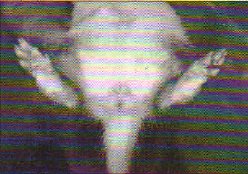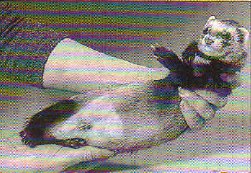Back to Basics - Spaying and Neutering
Neutering - the kindest cut! says DR JUNE McNICHOLAS who talks Ferrets First readers through this vitally important subject.
"Too many ferrets, not enough good homes" sums up the ongoing problem for rescues and welfares. But it's not just a matter of birth control, there are often health advantages in having your ferret neutered, as well as reductions in some behavioural problems. Here is a rundown of why (and when) you have your ferret neutered.
Many owners first need reassurance about anaesthesia risks. It is widely (but wrongly) believed that ferrets are high risk candidates. However, modern methods of anaesthesia are very good, quickly reversible and involve very minimal risk. In addition neutering procedures are very quick and involve very short times under anaesthesia. There are still a few vets who are inexperienced enough to say that ferrets are hard to operate on and are either reluctant or quote an extortionate fee. (You shouldn't have to pay any more than standard cat neutering charges.) If you need a ferret-friendly vet contact me, look on the NFWS website for a countrywide list of ferret vets, or approach your local ferret club to ask for referral to a ferret friendly vet - they really do exist!
HOBS
Type of operation - Castration, ie - removal of testicular tissue.
Procedure - Light anaesthesia or sedative with local anaesthesia. Two small incisions in the scrotum to remove testicles, leaving empty scotal sac. Frequently no stitches are put in, or are of dissolving type. The whole procedure takes just ten minutes and complications are very rare.
Age - Any age from around 20 weeks onwards
Why you should neuter your hob - The entire (un-neutered) hob has particular characteristics. From his first spring, he is hormonally deranged for a good part of the year with his only thoughts being centred on how to get hold of a jill. His coat becomes greasy, his eyes often become ringed with hormonal oil stains, he chunters continually - and he SMELLS! In addition he is highly likely to be very anti-social to other ferrets. Jills (entire or otherwise) will become the unwilling targets of his lust and he will almost certainly be aggressive to all other males. Besides being unpleasant for all concerned it can be potentially dangerous. I have come across cases of jills being forcibly mated via the rectum by an overexcited hob and subsequently haemorrhaging to death. Fights between hobs fequently result in injuries to both parties. He won't be very interested in you either because, bluntly, he'll have his brain in his underpants and not be interested in friendly platonic relationships! It is not surprising that such qualities make him difficult to live with for humans and other ferrets, and entire hobs often have a lonely existence.

24 hours after castration on an 18 week hob - virtually no scars!
Yet within two weeks of neutering, most hobs will have become more social to humans and other ferrets; be more interested in play, and have lost most - probably all - of their smell. They can be integrated with other ferrets and generally give every appearance of being happier and more contented.
Top of the list of reasons for not getting hobs neutered is the squeamishness of male owners who say: 'I couldn't do THAT to him! It's not natural'. (This is the perennial obstacle faced by campaigns for neutering across a wide range of species) Men go all watery-eyed at the mere mention of castration. I don't want to go all Freudian and psychoanalytical on you but, sorry chaps, that's a problem in your mind and something you've got to sort out, it's not an excuse for not doing right by your animal.
Just a word on vasectomy - in their minds and their behaviour, vasectomised hobs are entire. They don't know they are firing blanks. They will still be sex-mad, smelly and aggressive to other males. They have their uses for bringing jills out of season but it is not always the best alternative to neutering your jills.
So, on to JILLS
Type of operation - Spaying (oviohysterectomy) ie: removal of ovaries and womb.

Small spay wound on a very small jill
Procedure - General anaesthesia involves a small incision (usually less than 4cm) in the abdominal wall to remove ovaries and womb. Dissolvable stitches are increasingly being used to close the wound. It is a relatively short operation - less than 30 mins and the jill is frequently up and feeding an hour or two afterwards. Complications are unusual, although occasionally some ovarian remnants fail to be removed and the jill appears to be returning into season. This is increasingly rare and is solves by a second operation.
Age - Six months onwards. Many vets prefer jills not to be in season at the time of surgery: A 'jill-jab' can be given to bring her out of season and surgery performed a few weeks later.
Why you should have your jill neutered - Entire jills are at risk from a number of health problems. In my view the minimal risks involved in spraying are greatly outweighed by the reductions in the risks associated with pregnancy and birth, phantom pregnancies, pyometra (a womb infection), and hyperoestrogenism if left in season, leading to bone marrow problems, anaemia and quite a list of immune suppression problems. Spaying may be a bigger operation than castration but it is well worth the problems it avoids. Spayed jills often enjoy a healthier, longer life.
To sum up - It's easy to make light of the risks but we should remember that neutering is still an operation, although minor, so make sure you follow your vet's advice on pre-surgical and post-surgical care. Our practice suggests you do not starve ferrets for more than a couple of hours pre-op and then offer food and water as soon as he/she comes round from anaesthesia. It is also suggested that one ferret per pet carrier is best, and that the ferret is weighed at home the day before as well as weighed at the surgery
It's all common sense really. Neutering hobs and jills is becoming increasingly familiar for vets and, thankfully, it is helping to cut down unwanted litters and ferrets discarded because of behavioural problems. It really is worth adopting as best practice for pet ferrets.
